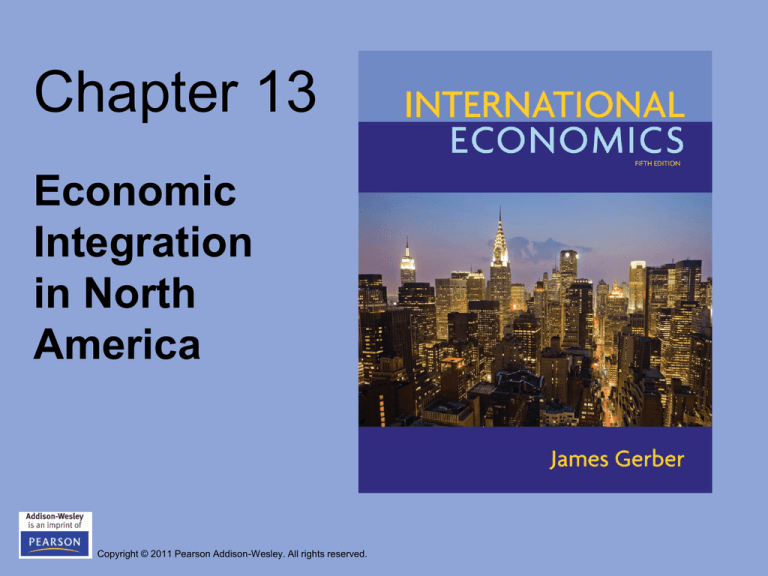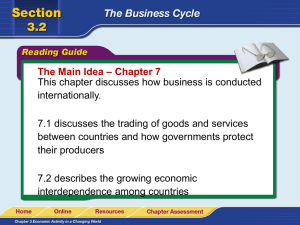
Chapter 13
Economic
Integration
in North
America
Copyright © 2011 Pearson Addison-Wesley. All rights reserved.
Chapter Objectives
• Explore the formation and impact of the
Canadian-United States Trade Agreement
(CUSTA), the North American Free Trade
Agreement (NAFTA), and the Dominican
Republic-Central American Free Trade Agreement
(DR-CAFTA)
• Understand the sources of political controversy
surrounding NAFTA’s negotiations and ratification
Copyright © 2011 Pearson Addison-Wesley. All rights reserved.
13-2
Introduction: Expanding Economic Relations
• The North American Free Trade Agreement
(NAFTA) came into effect on January 1, 1994
• For many U.S. economists, it seemed odd that a
relatively dry and straightforward agreement
would turn into one of the most contentious
economic issues of the 1990s
• However, there were many aspects of the
agreement that were controversial
Copyright © 2011 Pearson Addison-Wesley. All rights reserved.
13-3
Economic and Demographic
Characteristics of North America
• Enormous market: larger than the EU
• Vast income differences exist between Mexico on the one
hand, and the U.S. and Canada, on the other
– However, the purchasing power parity gap is smaller
– On average, the North American market is very rich
• The North American market is marked by numerous
difficult policy questions on migration and environmental
and labor standards, for example
Copyright © 2011 Pearson Addison-Wesley. All rights reserved.
13-4
TABLE 13.1
Population and GDP for NAFTA Countries, 2007
Copyright © 2011 Pearson Addison-Wesley. All rights reserved.
13-5
TABLE 13.2
Merchandise Trade Within the NAFTA
Region, 2007 (Millions of U.S. $)
Copyright © 2011 Pearson Addison-Wesley. All rights reserved.
13-6
FIGURE 13.1
Canada–United States Total Trade,
1985-2008
Copyright © 2011 Pearson Addison-Wesley. All rights reserved.
13-7
The Canada-U.S. Trade Relationship: The
Canadian–U.S. Trade Agreement (CUSTA) of 1989
• Helped Canada overcome growing U.S.
protectionism and Asian competitiveness
– However, many Canadians feared competition by U.S.
firms, erosion of Canada’s social programs, and U.S.
cultural influence
• Rather modest impact
– In 1989–1994, U.S. exports to Canada grew by 46.6%,
and Canadian exports to the U.S. by 55%
– Canadian fears were largely unfounded
Copyright © 2011 Pearson Addison-Wesley. All rights reserved.
13-8
Recent Mexican
Economic History
• The decision to seek closer economic ties to the
United States was one of many major policy
changes that Mexico made between the late
1980s and early 1990s
• Mexico’s shift from a closed and inward economic
orientation to an open and outward set of policies
began in the mid-1980s after a long period of
crisis caused by international trends and a series
of domestic policy mistakes
Copyright © 2011 Pearson Addison-Wesley. All rights reserved.
13-9
The Slowdown in Economic Growth
• In the late-1970s, Mexico was prospering due to
high revenues from oil production
• However, problems emerged in 1981
– World oil prices declined, reducing Mexico´s credit
worthiness
– A dramatic rise in U.S. interest rates increased the
interest charged on Mexico’s debt with commercial
banks
• In August 1982, the debt crisis began: Mexico
suspended payments of the principal of its debts
Copyright © 2011 Pearson Addison-Wesley. All rights reserved.
13-10
The Lost Decade of the 1980s
• The 1980s was considered the “Lost Decade” in
Latin America: GDP growth was nonexistent,
foreign capital stopped flowing in, credit became
scarce, investment declined
• Between the end of World War II and 1980s, Mexico
followed inward-oriented import substitution
industrialization (ISI) policies: industrial policies targeting
the development of manufacturing sectors that can
compete against imported goods
Copyright © 2011 Pearson Addison-Wesley. All rights reserved.
13-11
Economic Policy Reforms in the
Mexican Economy
• The economic crisis stemmed from
macroeconomic mismanagement:
large government expenditures had
increased borrowing and indebtedness
• Budget cuts and inflation had a social
cost: real wages fell by 40–50% in
1983–1988
Copyright © 2011 Pearson Addison-Wesley. All rights reserved.
13-12
The North American Free Trade
Agreement (NAFTA) of 1994
• As a result of the agreement, tariffs on about half of the
goods traded between U.S. and Mexico were eliminated
immediately
– Most dramatic changes in Mexico were: average tariffs
on U.S. goods fell from 10% to 2.9% between 1993 and
1996, while U.S. tariffs on Mexican goods fell from
2.07% to 0.65%
• NAFTA specified content requirements for goods subject
to free trade
• NAFTA established a system of trade dispute resolution
Copyright © 2011 Pearson Addison-Wesley. All rights reserved.
13-13
The NAFTA Debate in the United
States: Labor Issues
• NAFTA reignited contention on trade policy in
the U.S.
– Blue collar labor unions feared jobs would
migrate to the South given Mexico’s lower labor
costs
• Political opposition forced Canada, Mexico,
and the U.S. to attach a labor-side agreement
to NAFTA, which was the North American
Agreement on Labor Cooperation
Copyright © 2011 Pearson Addison-Wesley. All rights reserved.
13-14
The NAFTA Debate in the United
States: Environmental Issues
• Environmental groups feared that (1) polluting
U.S. and Canadian firms would move to Mexico,
and (2) pollution would increase along the U.S.Mexico border
• Environmental-side agreements to NAFTA were
the North American Agreement on
Environmental Cooperation and the North
American Development Bank (NADBank) to
help finance border cleanup costs
Copyright © 2011 Pearson Addison-Wesley. All rights reserved.
13-15
The NAFTA Debate in the United
States: Immigration
• Illegal immigration is a contentious issue in U.S.Mexico relations
– Proponents argue that illegal immigrants support the
U.S. economy by buying goods and services and help
keep prices low by increasing labor supply
– Opponents argue that the U.S. should not ignore illegal
behavior and that the increased labor from illegal
immigration suppresses wages for legal workers
Copyright © 2011 Pearson Addison-Wesley. All rights reserved.
13-16
The NAFTA Debate in the U.S.:
Immigration (cont.)
• Attempts at stricter border enforcement have been
largely unsuccessful at stopping illegal
immigration
– The border is too long – 2,000 miles
– The economic incentive the enter the U.S. is too high
– Nearly half of the illegal immigrants entered legal, but
did not return home when their visa’s expired
Copyright © 2011 Pearson Addison-Wesley. All rights reserved.
13-17
Figure 13.2 Real Value Added and
Employment in Manufacturing, 1960-2008
Copyright © 2011 Pearson Addison-Wesley. All rights reserved.
13-18
The Impact of NAFTA
on the U.S. Economy
• The local effects of NAFTA on trade and
economy are dramatic especially in the
U.S.-Mexican border
• However, Mexico’s economy is 5% of the
U.S. economy: NAFTA has had a very
modest impact on the overall U.S. trade
balance and current account or on jobs and
wages
Copyright © 2011 Pearson Addison-Wesley. All rights reserved.
13-19
The Impact of NAFTA on U.S.Mexico Trade
• Trade flows between U.S. and Mexico have shot up
• The growth in trade between all three NAFTA partners
indicates increased specialization, economies of scale,
and efficiency
• However, the exact impact of NAFTA is hard to assess
– Bilateral trade has expanded already since 1989 thanks to
Mexico’s economic reforms
– Mexico’s 1994–1995 peso crisis and recession caused U.S.
exports to decline momentarily to Mexico
Copyright © 2011 Pearson Addison-Wesley. All rights reserved.
13-20
FIGURE 13.3
United States–Mexico Merchandise
Trade, 1989-2005
Copyright © 2011 Pearson Addison-Wesley. All rights reserved.
13-21
The Economic Impact of NAFTA
in Summary
• Canada: trade with Mexico is growing, but still
represents a small part of Canada’s trade
• The U.S.: NAFTA has had local effects especially
along the border, but had a small impact on the
overall U.S economy
• Mexico: NAFTA has had an important impact on
trade flows and solidified economic reforms
Copyright © 2011 Pearson Addison-Wesley. All rights reserved.
13-22
The Expansion of NAFTA
• In July 2005, the U.S. ratified the Dominican
Republic-Central American Free Trade Agreement
(DR-CAFTA) between:
– Dominican Republic
– Guatemala
– Honduras
– El Salvador
– Nicaragua
– Costa Rica
Copyright © 2011 Pearson Addison-Wesley. All rights reserved.
13-23
TABLE 13.3
Population and GDP for the DR-CAFTA
Countries, 2007
Copyright © 2011 Pearson Addison-Wesley. All rights reserved.
13-24
The Future of NAFTA:
A North American Community?
• Relative to the European Union, NAFTA is in an
early stage of economic integration.
• Deeper integration among the members will
require:
– Increased labor mobility
– The establishment of permanent governing bodies
– A focus on development to close the economic gap
between Mexico and the other members
Copyright © 2011 Pearson Addison-Wesley. All rights reserved.
13-25
TABLE 13.4
Doing Business in the NAFTA
Countries, 2009
Copyright © 2011 Pearson Addison-Wesley. All rights reserved.
13-26
TABLE 13.4 (continued)
Doing Business in the NAFTA
Countries, 2009
Copyright © 2011 Pearson Addison-Wesley. All rights reserved.
13-27
Copyright © 2011 Pearson Addison-Wesley. All rights reserved.
13-28






